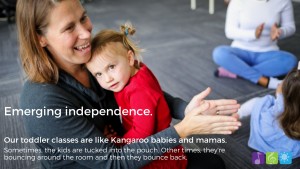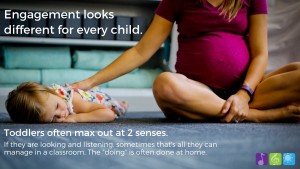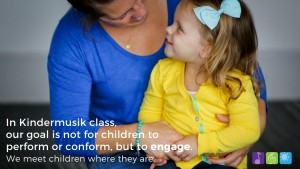By Kathy Morrison, Director
Do you ever wonder if your child is doing the right thing in Kindermusik class?
Should he be sitting and copying everything the teacher is doing?
Should she be sitting when she’s moving and moving all over the room?
Does this sound familiar? My child is sitting on my lap, but not DOING anything else.
Or he is sitting in the back of the room separated from the group? What does that mean?
Or this – My child is wandering around and looking at the window. Does this mean she is not ready for this class?
Here’s what we know to be true: Engagement looks different for every child.
Allow me to provide a few examples.
The Clinger.
Consider the child that will NOT walk independently for a circle dance but is clawing at Mom’s legs.
It’s a struggle right? Your child is heavy and on top of that, you really want them to begin to walk on their own. So what do you do?
Empathy builds self-confidence. If your child is not yet ready to walk independently or sit without you, start with compassion. The reassurance now will lead to independence later.
This may be a good time to snuggle your child and help her learn how to dance with others in a group. A large group activity can feel overwhelming for some children. They need you close in order to feel safe and ready to greet others in the dance. Dancing in your arms IS considered one of the best forms of participation and engagement. You are your child’s first and best teacher. You are modeling how to be social in this delightful setting. You are teaching them to greet a new friend with eye contact and a wave. It starts small and builds from there.
The Non-Conformist.
Perhaps your child is determined to turn those sand blocks into a choo-choo train while everyone else is tapping or clapping to the beat. What do you do
Our goal is not to have children perform or conform, but to engage. We want to meet them where they are and build from there with affirmation and scaffolding.
First, let me assure you – your child IS engaged. There are many ways to keep the beat with a choo-choo train of sand blocks. The goal is beat keeping – so if your child is more likely to engage with sandblock trains, then chug and toot to the beat. It’s fun and affirming, too, building self-confidence while nurturing their love of music.
The Mover.

Movement is the key to learning!
Your child is learning to move and using all that movement to develop the whole brain, forcing the sides of the brain to talk to each other. We are
celebrating that your child feels safe to move around independently in class.
The Observer.
For the child that is just sitting and watching and mom feels like her child isn’t engaged…this is normal and a stage very common for toddlers and young preschoolers.
Jane Healy tells us that toddlers often max out at 2 senses.
If they are watching and listening, sometimes that’s all they can do. When your child is at home, there’s no class or teacher to watch or listen to. That’s l
The Wanderer.
For the child that is wandering and looking out the window, ask mom how she thinks her child learns best? By looking, watching, feeling, touching, moving?
We know that aural learners do not need to watch or attend to be learning. (No, that is not intuitive.) Often our aural learners can answer every question we ask, even though they are on the other side of the room while we are reading the story or learning a new song. We’ve discovered that they may be singing along while facing the other way. Or perhaps the child is doing the motions to a song, but in a way that’s not obvious at first because they are NOT watching or sitting with the group. Here’s the good news – They don’t have to!
Take some time to discover more about the subtle ways your child is engaging in class that you may not have realized before. If you have questions, please ask. Our desire is to partner with every Kindermusik parent in order to help develop their child’s brain and body using music and movement.
We are committed to nurturing your child’s love of music while building their self-confidence, teaching them to work in a small group where they feel like they belong! It’s all part of our mission: to change the world through music, one child at a time.



Leave a Reply